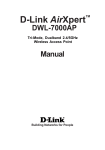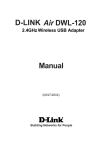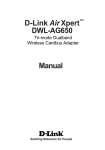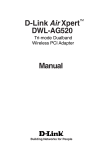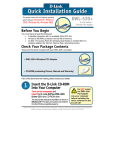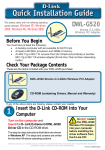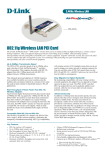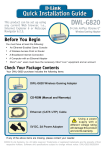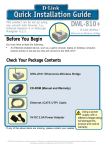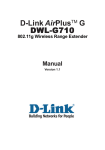Download D-Link Air DWL-120 Specifications
Transcript
This product works with the following operating system software: Windows XP, Windows 2000, Windows Me, Windows 98se DWL-120+ 2.4GHz USB Wireless Adapter Before You Begin You must have at least the following: • You will need a computer with an available USB port to connect the DWL-120+ Wireless USB adapter. • At least a 300 MHz processor and 32 MB of memory • An 802.11b Access Point (for Infrastructure Mode) or another 802.11b wireless adapter (for Ad-Hoc; Peer-to-Peer networking mode.) • Properly Installed and Working USB Controller. Check Your Package Contents These are the items included with your DWL-120+ purchase: DWL-120+ Wireless USB Adapter CD-ROM (containing Drivers, Manual and Warranty) Mini-USB Cable If any of the above items are missing, please contact your reseller. ©2003 D-Link Systems, Inc. All rights reserved. Trademarks or registered trademarks are the property of their respective holders. Software and specifications subject to change without notice. 1G-BDWL-120+ 04082003 Insert the D-Link CD-ROM Into Your Computer Do NOT install Turn on the computer and Insert the D- Link Air DWL-120+ Driver CD in the CD-ROM drive. The step-by-step instructions that follow are shown in Windows XP. The steps and screens are similar for the other Windows operating systems The Install Screen will appear. Click Install Drivers If the CD Autorun function does not automatically Go to Start > Run on your computer, then type “D:\Setup.exe.” If it does start, proceed to the next screen. Type “D:\Setup.exe.” The letter “D” represents the letter of the CD-ROM drive. Your CD-ROM drive may be a different drive letter. Click OK Click Next the DWL-120+ USB Adapter into your computer before installing the driver software on the D-Link CD! Click Next Click No, I will restart my computer later Click Finish Shut down Your Computer Antenna Used to wirelessly connect to 802.11b networks. Link/Power LED Link - Blinks when data is being transmitted through the wireless connection. Power - Indicates that the DWL120+ is properly installed in the computer. Mini-USB Port Used to connect the DWL-120+ to your computer. Installing the DWL-120+ Wireless USB Adapter to Your Computer A. Make sure to turn off your computer. B. Firmly insert one end of the USB cable (larger plug) into your computer’s USB Port. C. Firmly insert the other end of the USB cable (smaller plug) into the DWL-120+. Restart Your Computer When you restart your computer this Found New Hardware Wizard (Windows XP) screen will appear: Select Install the software automatically (Recommended) Click Next Windows XP will automatically load the driver files. Click Finish For Windows XP/2000, a screen similar to this Digital Signature Not Found screen may appear during the installation. Click Yes to continue the installation For Windows Me and 98SE, this screen may appear. Click Yes to finalize the installation Your Installation is Complete! After you’ve continued in Windows XP (or after the computer restarts in the other Windows operating systems), the D-Link Air DWL-120+ Configuration Utility will automatically start and the utility icon will appear in the bottom right hand corner of the desktop screen (systray). If this icon appears GREEN, then you have successfully installed the DWL-120+, are connected to a wireless network and are ready to communicate! If the utility icon does not appear, double-click the shortcut icon that has appeared on your desktop. Double-click the utility icon to use the configuration utility. For Windows XP, if you wish to use the AirXpert Utility, please do the following steps. Click the XP Networking icon to use the Zero Configuration Wireless Settings. Click Advanced Your Installation is Complete!(cont.) Uncheck “Use Windows to configure my wireless network settings.” Click OK Appendix Using the Configuration Utility A. Status: Displays the MAC Address of the Access Point that is associated with the DWL-120+. B. SSID: The Service Set Identifier is the name assigned to the wireless network. The factory SSID setting is set to default A B C D E F C. TxRate: The default setting is 11Mbps; however, TxRate settings are automatically determined by the DWL120+ depending on the distance from the access point. D. Channel: Displays the channel information. By default, the channel is set to 6 and selection is automatically determined by the Access Point. F. Data Rate: Graphically displays the statistics of data transmitted and received. E. Link Quality / Signal Strength: Displays the wireless signal strength for the DWL-120+ wireless connection to the access point. Appendix (cont.) G. SSID: The Service Set Identifier is the name assigned to the wireless network. The factory SSID setting is set to default. H. Wireless Mode: The factory setting is set to Infrastructure Mode. Ad-Hoc mode is used for peer-to-peer networking. I. Channel: By Default, the channel is set to 6. Channel selection is automatically determined by the DWL120+ depending on the channel setting of the access point selected for association. To change the channel settings, the Wireless Mode must be set to Ad-Hoc. G H I J K L J. TxRate: You can adjust the transmission rate to get the best signal possible depending on your usage and environment. K. Preamble: By default, D-Link AirPlus Products are set to Long Preamble. The Preamble defines the length of the CRC block (Cyclic Redundancy Check is a common technique for detecting data transmission errors) for communication between the Access Point and wireless network adapters. High network traffic areas shout use the Shorter Preamble type. L. Power Mode: By default, Power Mode is set to Continuous Access Mode. Continuous Access Mode - this default setting consumes the most power. Maximum Power Save this setting consumes the lease power. Power Save - this setting consumes a moderate amount of power. IP Address Configuration To connect to a network, make sure the proper network settings are configured for DWL-120+. For Microsoft Windows XP: Go to Start > right click on My Network Places > select Properties > Double-click on the Network Connection associated with the DWL-120+. Click Internet Protocol (TCP/IP) Click Properties Dynamic IP address setup Used when a DHCP server is available on the local network. (i.e. Router) Select Obtain an IP address automatically (if the Wireless Router or Access Point has DHCP server enabled) Select Obtain DNS server address automatically Click OK Static IP address setup Used when a DHCP server is not available on the local network. Select Use the following IP address IP address: 192.168.0.51 Subnet mask: 255.255.255.0 Input a static IP address in the same range as the Wireless Router or Access Point. Click OK For Windows 2000 users: Go to Start > Settings > Network and Dial-up Connections > Double-click on the Local Area Connection associated with the DWL-120+ > select Properties Click Internet Protocol (TCP/IP) Click Properties Dynamic IP address setup Used when a DHCP server is available on the local network. (i.e. Router) Select Obtain an IP address automatically (if the Wireless Router or Access Point has DHCP server enabled) Select Obtain DNS server address automatically Click OK Static IP address setup Used when a DHCP server is not available on the local network. Select Use the following IP address IP address: 192.168.0.52 Subnet mask: 255.255.255.0 Default Gateway: 192.168.0.1 DNS Address: 192.168.0.1 Input a static IP address in the same range as the Wireless Router or Access Point. Click OK












